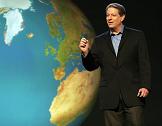 Riveting. Terrifying. Inspiring. Exasperating. Makes you want to grab people off the street as you exit and shove them in the door so they can see it too. Causes you to catalogue all the little things you could do, but are not yet doing to make a difference. Gives you hope while at the same time adds incredible worry and even despair about the state of things. These are all ways to describe the experience of watching “An Inconvenient Truth,” the new documentary featuring the global warming talk that Al Gore has been giving all over the world for years.
Riveting. Terrifying. Inspiring. Exasperating. Makes you want to grab people off the street as you exit and shove them in the door so they can see it too. Causes you to catalogue all the little things you could do, but are not yet doing to make a difference. Gives you hope while at the same time adds incredible worry and even despair about the state of things. These are all ways to describe the experience of watching “An Inconvenient Truth,” the new documentary featuring the global warming talk that Al Gore has been giving all over the world for years.
The movie is, more or less, a straight lecture–a two-hour virtual PowerPoint presentation–with some deviations exploring Gore’s back story and a brief cartoon explaining global warming. Yet somehow, it had me glued to my seat. The producers of “An Inconvenient Truth” somehow managed to take Gore’s highly polished presentation straight to the big screen with wild success.
The star of the show is Earth, and we are the villains–the “we” here, of course, is largely comprised of residents of the United States, which holds the lion’s share of responsibility when it comes to destroying civilization as we know it, and do so not-too-slowly, as it turns out. Gore is accessible in his explanations, does very little political blaming, and convincingly argues his point: that once you realize what we are really doing to the planet, it becomes a moral imperative to do something about it. And after all the bad news of what’s gone wrong, he shares the hopeful reality that all the technology necessary to reverse global warming is already available, though he adds the depressing caveat that “we have everything we need, save political will.”
The ultimate moral imperative rests on our shoulders: find that political will. One of the funniest but most convincing moments comes when Gore stands in front of a giant photograph of a scale. On one side of the scale are bars of gold, and on the other, Earth. Gore proceeds to comically debate between choosing bars of gold (complete with amusing sound effects) and… drum roll… the entire planet(!), illustrating the fact that, as a country, we seem to be caught in a debate about hoarding dollars vs. killing our world. How is that a choice? When Gore puts it this way, opponents will be hard pressed to defend themselves convincingly.
Finally, but truly powerfully, the documentary has a simple but clever way of rolling the credits –scrolling all sorts of practical, step-by-step advice for saving the world (or “taking action”), including everything from recycling and buying hybrid cars (if you can afford it) to “if you pray, pray that people will find enough strength to change,” and follow an old African proverb that says, “When you pray, use your feet.”
As I sat through the film, at different moments I found my mind wandering to the “What Would Jesus Drive?” campaign that erupted several years back, which was critical of the disturbing rise in gas guzzling SUV’s on the highways across the U.S., urging Christians to be more environmentally conscious and stop driving these cars. As I remembered this campaign, I began thinking: “What Would Jesus See?” in terms of movies this summer, and the answer is obvious: this movie.
And when you go see it, make sure you stay until the very last credits. They can save the world.


